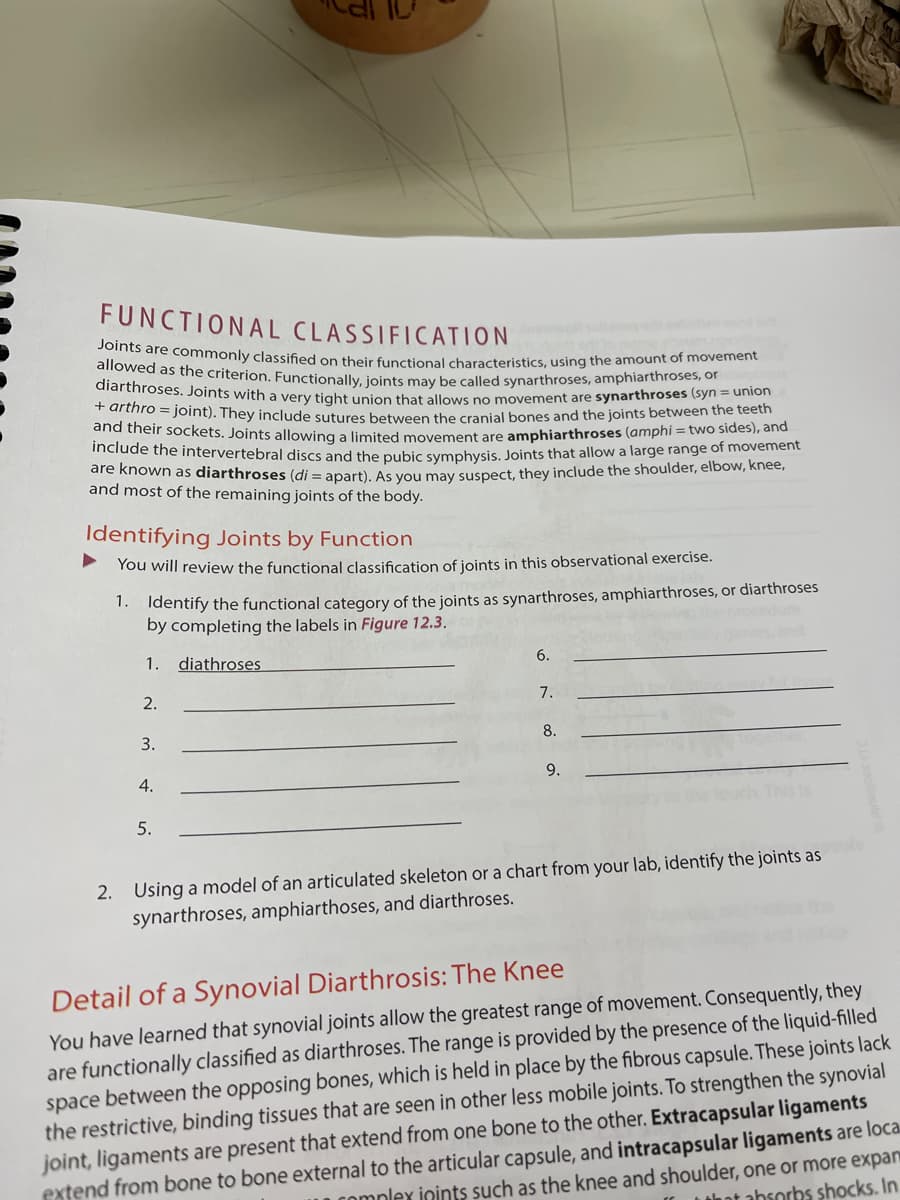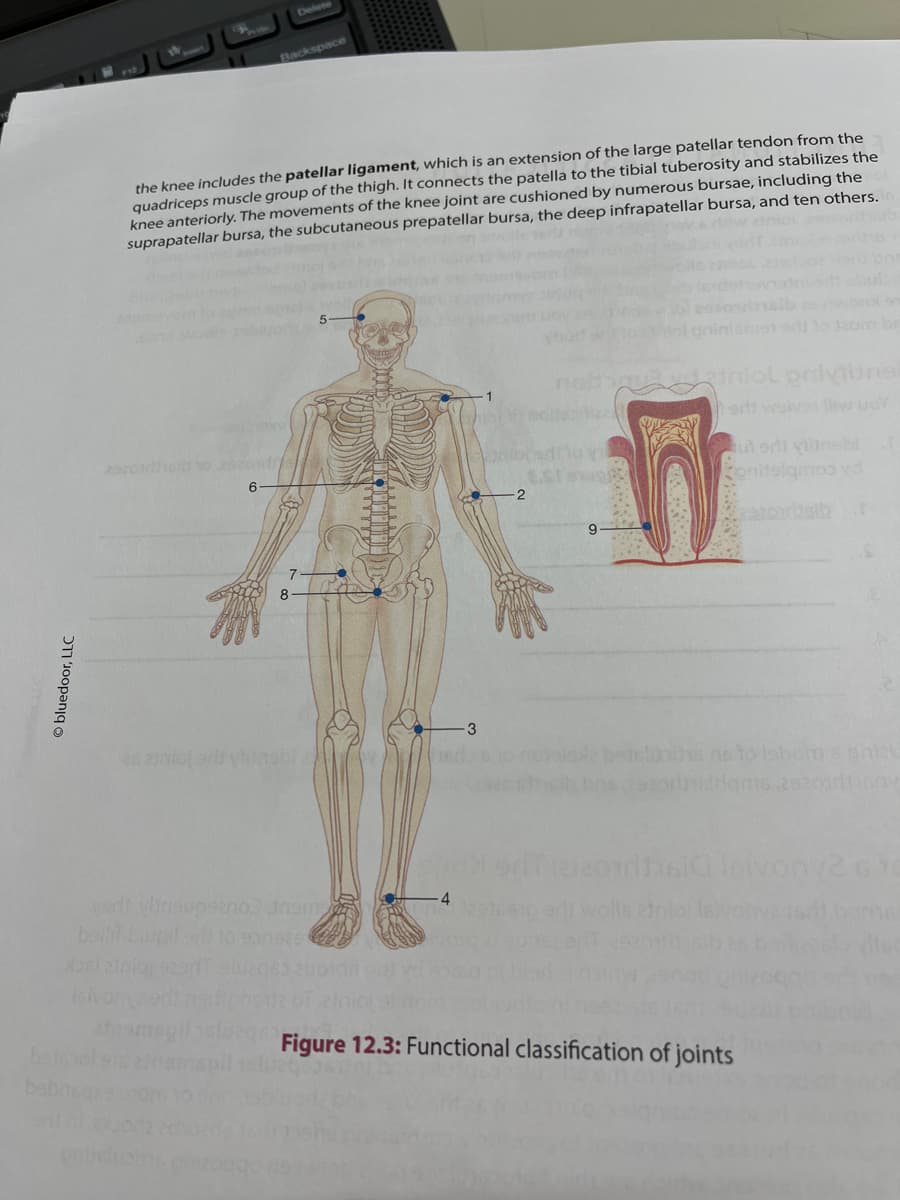FUNCTIONAL CLASSIFICATION Joints are commonly classified on their functional characteristics, using the amount of movement allowed as the criterion. Functionally, joints may be called synarthroses, amphiarthroses, or diarthroses. Joints with a very tight union that allows no movement are synarthroses (syn = union + arthro = joint). They include sutures between the cranial bones and the joints between the teeth and their sockets. Joints allowing a limited movement are amphiarthroses (amphi = two sides), and include the intervertebral discs and the pubic symphysis. Joints that allow a large range of movement are known as diarthroses (di= apart). As you may suspect, they include the shoulder, elbow, knee, and most of the remaining joints of the body. Identifying Joints by Function You will review the functional classification of joints in this observational exercise. 1. Identify the functional category of the joints as synarthroses, amphiarthroses, or diarthroses by completing the labels in Figure 12.3. 1. diathroses 2. 3. 4. 5. 6. 7. 8. 9. 2. Using a model of an articulated skeleton or a chart from your lab, identify the joints as synarthroses, amphiarthoses, and diarthroses.
FUNCTIONAL CLASSIFICATION Joints are commonly classified on their functional characteristics, using the amount of movement allowed as the criterion. Functionally, joints may be called synarthroses, amphiarthroses, or diarthroses. Joints with a very tight union that allows no movement are synarthroses (syn = union + arthro = joint). They include sutures between the cranial bones and the joints between the teeth and their sockets. Joints allowing a limited movement are amphiarthroses (amphi = two sides), and include the intervertebral discs and the pubic symphysis. Joints that allow a large range of movement are known as diarthroses (di= apart). As you may suspect, they include the shoulder, elbow, knee, and most of the remaining joints of the body. Identifying Joints by Function You will review the functional classification of joints in this observational exercise. 1. Identify the functional category of the joints as synarthroses, amphiarthroses, or diarthroses by completing the labels in Figure 12.3. 1. diathroses 2. 3. 4. 5. 6. 7. 8. 9. 2. Using a model of an articulated skeleton or a chart from your lab, identify the joints as synarthroses, amphiarthoses, and diarthroses.
Human Anatomy & Physiology (11th Edition)
11th Edition
ISBN:9780134580999
Author:Elaine N. Marieb, Katja N. Hoehn
Publisher:Elaine N. Marieb, Katja N. Hoehn
Chapter1: The Human Body: An Orientation
Section: Chapter Questions
Problem 1RQ: The correct sequence of levels forming the structural hierarchy is A. (a) organ, organ system,...
Related questions
Question

Transcribed Image Text:FUNCTIONAL CLASSIFICATION
Joints are commonly classified on their functional characteristics, using the amount of movement
allowed as the criterion. Functionally, joints may be called synarthroses, amphiarthroses, or
diarthroses. Joints with a very tight union that allows no movement are synarthroses (syn union
+ arthro joint). They include sutures between the cranial bones and the joints between the teeth
and their sockets. Joints allowing a limited movement are amphiarthroses (amphi = two sides), and
include the intervertebral discs and the pubic symphysis. Joints that allow a large range of movement
are known as diarthroses (di= apart). As you may suspect, they include the shoulder, elbow, knee,
and most of the remaining joints of the body.
Identifying Joints by Function
You will review the functional classification of joints in this observational exercise.
1.
Identify the functional category of the joints as synarthroses, amphiarthroses, or diarthroses
by completing the labels in Figure 12.3.
1.
diathroses
2.
T
3.
4.
5.
6.
7.
8.
9.
2. Using a model of an articulated skeleton or a chart from your lab, identify the joints as
synarthroses, amphiarthoses, and diarthroses.
Detail of a Synovial Diarthrosis: The Knee
You have learned that synovial joints allow the greatest range of movement. Consequently, they
are functionally classified as diarthroses. The range is provided by the presence of the liquid-filled
space between the opposing bones, which is held in place by the fibrous capsule. These joints lack
the restrictive, binding tissues that are seen in other less mobile joints. To strengthen the synovial
joint, ligaments are present that extend from one bone to the other. Extracapsular ligaments
extend from bone to bone external to the articular capsule, and intracapsular ligaments are loca
complex inints such as the knee and shoulder, one or more expan
hot absorbs shocks. In

Transcribed Image Text:Ⓒbluedoor, LLC
the knee includes the patellar ligament, which is an extension of the large patellar tendon from the
quadriceps muscle group of the thigh. It connects the patella to the tibial tuberosity and stabilizes the
knee anteriorly. The movements of the knee joint are cushioned by numerous bursae, including the
overwatniol
suprapatellar bursa, the subcutaneous prepatellar bursa, the deep infrapatellar bursa, and ten others.
belin
6
afnsm
Delete
Backspace
8
vertybinisupaano) anem
-3
1
W
Konitelqmos vd
its no to labom s phict
Figure 12.3: Functional classification of joints
610
Expert Solution
This question has been solved!
Explore an expertly crafted, step-by-step solution for a thorough understanding of key concepts.
This is a popular solution!
Trending now
This is a popular solution!
Step by step
Solved in 3 steps

Recommended textbooks for you

Human Anatomy & Physiology (11th Edition)
Anatomy and Physiology
ISBN:
9780134580999
Author:
Elaine N. Marieb, Katja N. Hoehn
Publisher:
PEARSON

Anatomy & Physiology
Anatomy and Physiology
ISBN:
9781259398629
Author:
McKinley, Michael P., O'loughlin, Valerie Dean, Bidle, Theresa Stouter
Publisher:
Mcgraw Hill Education,

Human Anatomy
Anatomy and Physiology
ISBN:
9780135168059
Author:
Marieb, Elaine Nicpon, Brady, Patricia, Mallatt, Jon
Publisher:
Pearson Education, Inc.,

Human Anatomy & Physiology (11th Edition)
Anatomy and Physiology
ISBN:
9780134580999
Author:
Elaine N. Marieb, Katja N. Hoehn
Publisher:
PEARSON

Anatomy & Physiology
Anatomy and Physiology
ISBN:
9781259398629
Author:
McKinley, Michael P., O'loughlin, Valerie Dean, Bidle, Theresa Stouter
Publisher:
Mcgraw Hill Education,

Human Anatomy
Anatomy and Physiology
ISBN:
9780135168059
Author:
Marieb, Elaine Nicpon, Brady, Patricia, Mallatt, Jon
Publisher:
Pearson Education, Inc.,

Anatomy & Physiology: An Integrative Approach
Anatomy and Physiology
ISBN:
9780078024283
Author:
Michael McKinley Dr., Valerie O'Loughlin, Theresa Bidle
Publisher:
McGraw-Hill Education

Human Anatomy & Physiology (Marieb, Human Anatomy…
Anatomy and Physiology
ISBN:
9780321927040
Author:
Elaine N. Marieb, Katja Hoehn
Publisher:
PEARSON